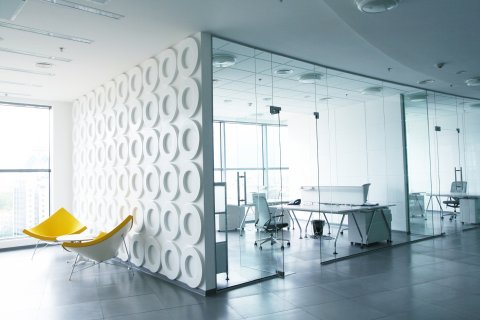Workplace management involves all strategies, practices, and processes used to oversee and optimise the daily operations of a workplace. Effective workplace management is crucial for boosting employee morale, managing risks, attracting top talent, and staying compliant with workplace regulations.
An engaged and productive workforce is every leader’s goal. Resources are poured into training, social activities, and wellbeing initiatives – all meant to improve employee satisfaction and performance.
But what about the workplace environment itself? Optimising workplaces to enable high-performing employees is a lever many have yet to pull. Faced with the challenges and opportunities posed by hybrid working, the top-performing businesses of tomorrow are already investing in a new approach to workplace planning.
What is workplace management?
Workplace management is a comprehensive strategy that businesses use to manage various elements within a work environment, including personnel, tasks, resources, and facilities. It consists of all the processes, services, facilities, assets and technologies that enhance the workplace experience.
The best workplace management solution will centre employee needs and patterns from across an organisation.
Modern workplace management platforms go well beyond the traditional scope of facility management software. They unify core processes like strategic planning, day-to-day maintenance, security, catering, and services management, ensuring that each part of the workplace enhances productivity, collaboration, and ultimately, business value.
By consolidating these operations into a single system, organisations can better track usage, align services with actual needs, and provide a user-friendly experience for employees.
The evolution of workplace management solutions
In recent years, workplace management software has developed in four main ways. Most obviously, many organisations have changed their definition of workspace – and as such, their workplace management strategies have had to evolve. They now are expected to maintain a workplace design that can handle hybrid, flexible and remote work alongside traditional in-person roles.
Secondly, workplace management has evolved from a patchwork of niche tools into a user-friendly, integrated solution. Years ago a workplace would have a room booking app entirely separate from its workplace health and safety management system. Today’s workplace management solutions can incorporate everything from carbon emission monitoring to financial analysis. A single portal keeps track of all projects, assets, leases, orders, and employee information.
Also, the data available to be captured, analysed, shared, and acted upon is orders of magnitude greater than a decade ago. Holding a coherent data lake (a centralised repository) rather than a disparate collection of databases enables easier use of informative statistics. Connecting with smart devices and reporting on digital and physical interactions aids fast, reliable decision-making.
Finally, an Internet of Things (IoT) enabled workplace management software is now considered standard. Machine learning will be at the heart of the next advance in business intelligence. And sensor-based occupancy tracking systems monitor how spaces are used in real time, helping organisations understand peak usage times and underutilised areas. All this data can inform better space allocation decisions, reduce costs, and enhance employee comfort and productivity.
When implemented appropriately, an integrated workplace management system (IWMS) accounts for all of this evolution. Data-driven decision-making and using a single source of truth supports work wherever and however it is done: hybrid, remote, or otherwise.
The 4 benefits of workplace management
Every workplace manager – whether they work under a banner of facilities, HR, campus services, or otherwise – has a different idea of what excellence would look like. However, we see four main benefits of workplace management time and again:
1. Managing space to optimise every square foot
The use of physical space is a linchpin in many workplace initiatives, and particularly those related to sustainability and carbon footprint. Space management asks how rooms are being filled and if they can be put to more effective use. Workplaces may seem to be well utilised, but data often displays variability in occupancy rates.
- Is this because of working patterns, or because the office layout and design aren’t meeting employee needs?
- Where can wasted space be cut down?
- Is a desk booking system available for employees who aren’t based in the office full-time?
Space isn’t just about desk space or meeting rooms. Consider your organisation’s investment in storage, common areas, specialist workstations, and administrative areas.
Key metrics:
- Space utilisation rate: percentage of desks/offices occupied
- Occupancy density: number of employees per square foot
- Meeting room utilisation: percentage of meeting rooms booked and used
Analysing these metrics can reveal opportunities to consolidate space, reduce lease costs, or redesign the office layout for better efficiency.
2. Employee experience and engagement
Knowledge workers—those who solve problems, drive innovation, and lead teams—are essential to modern organiations. But their ability to thrive often depends on more than just their skills or motivation. When the workplace environment is poorly designed or overly complex, even the most capable employees can feel drained and distracted.
Too often, these professionals lose valuable time navigating inefficient systems or dealing with administrative hurdles—time that could be better spent on strategic, creative, or high-impact work. Add to that suboptimal workspaces or hardware, and the gap between their potential and the environment only grows. Over time, this disconnect can lead to frustration and, ultimately, departure.
There are myriad ways to improve employee satisfaction by boosting workplace engagement.
Workplace apps, for example, empower employees to tailor their experience. A user-friendly interface removes a person’s obstacles to the services they need: cleaning, catering, and room scheduling software. Data from app usage then flows back into future decision-making.
A supported workforce is key to retaining employees, and the best workplace management strategies take this into account. Measuring employee experience can be done through surveys, feedback forms, and app usage data.
Key metrics for employee engagement:
- Employee satisfaction scores: how employees feel about their work environment, leadership, and growth opportunities
- Employee net promoter score (eNPS): how likely employees are to recommend the organisation as a great place to work
- Employee retention rates: tracks the percentage of employees who remain over a given period
Tracking these metrics helps organisations understand the impact of their workplace design and services on employee morale and engagement.
3. Cost efficiency and resource optimisation
Effective workplace management reduces operational costs by assessing the use of space and resources. Processes should be put in place to regularly review the use of expensive resources like fleet or specialized equipment, which often have low occupancy rates relative to their costs. Where cost efficiency is about minimizing expenses, resource optimization is more about maximizing the effective use of those resources, which can lead to cost savings, but isn't always the primary goal.
As well as assessing utilisation of space and resources, facilities professionals should also take into account qualitative data such as feedback management. Armed with the data, workspace managers can more easily justify cost-cutting, resource investment, or changing equipment layout.
Key metrics for cost efficiency:
- Cost per employee: total workplace costs divided by the number of employees
- Energy consumption per square foot
- Maintenance costs
Analysing these metrics can identify areas for cost savings, such as reducing energy waste or optimising maintenance schedules. KPIs for resource optimisation are more focused on using resources effectively and efficiently.
Key metrics for resource optimisation:
- Utilisation rates: desk utilisation, meeting room utilisation, equipment utilisation, space utilisation
- Occupancy rates: similar to utilisation but focused on people
- Employee productivity metrics: for example, project completion rates
4. Workplace strategy: aligning with organisational goals
Everything about a workplace should be in service of a business objective. When organisational goals are set or updated, it’s crucial that the workplace strategy enables employees to work towards achieving those goals. An example of this might be around growth in certain areas of an industry, or working towards entering a new market.
Similarly, when a workforce changes, the workplace strategy has to flex to meet the changing needs. Workplace strategies might focus on shared workplace concepts, working from home policies, and transformations from fixed place to flexible or shared workspaces. The KPIs are usually tied to the business goal.
Key metrics:
- Collaboration frequency: if the goal is to increase collaboration, metrics like the number of collaborative spaces used or the frequency of cross-departmental meetings could be tracked.
- Employee wellbeing: if the goal is to improve employee wellbeing, metrics like employee absenteeism rates or participation in wellness programs could be relevant.
Adapting to hybrid work: new challenges and solutions
With more employees in physical spaces away from colleagues, hybrid and remote work have introduced a suite of new considerations for workplace planning. Careful management of the complexities of hybrid work will bring together a more resilient, adaptable workforce. Considerations to be taken into account are listed below:
Remote work communication in a hybrid setting: Communication shifts – from meeting-based to virtual tools – have changed the way employees use space. In-person time may be limited to specific kinds of discussions, or seasons in a year. Workplace management predicts, tracks, and prepares for these trends to ensure a space is working for everyone’s needs. For example, a workplace with many employees in hybrid roles may choose to reduce individual desks in favour of more collaborative spaces, but take on temporary office space during launches or sprints. Adjustable resource management is key for a hybrid workplace.
Assessing employee performance against the right metrics: HR managers will have noticed the move away from using office hours as a measurement of performance. Giving employees more autonomy over where and how they work, hybrid work represents a change from time-based management to outcome-based management.
Customised, flexible work arrangements: Employees saw what was possible when lockdowns and family commitments made work flex around other priorities. Understandably, workplaces able to continue offering that flexibility can retain hybrid employees for much longer. On the other hand, some employees need their work to come with an employer-associated physical space. Integrated workplace management systems are able to manage individual preferences to maximise team cohesion and performance. Keeping open feedback loops is key to developing successful policies for meetings and availability.
Increased dependency on technologies: All employees need the right tools to do their jobs. With more remote work, a higher dispersal of hardware will be experienced. This should come hand in hand with cybersecurity measures. In addition, remote employees are no longer within the care of a physical community. An increased dependency on technology – especially when meetings shift from offline to virtual – can present challenges around digital fatigue and boundaries between work and home life.
Challenges in implementing new workplace management strategies
While the benefits of effective workplace management are clear, organisations may face several challenges when implementing new strategies:
Employees and management may resist adopting new technologies or processes due to familiarity with existing systems. Effective communication and training programmes are essential to overcome this resistance and ensure a smooth transition.
Implementing advanced technologies like AI-powered space planning tools or sensor-based occupancy tracking systems often requires substantial initial investment. Organisations must weigh these costs against the long-term benefits and potential savings.
Collecting and analysing large amounts of data can be complex, and ensuring data privacy is crucial. Organisations must implement robust data management practices to protect employee information and comply with regulations.
Integrating new technologies with existing systems can be technically challenging. It may require specialised expertise and ongoing support to ensure seamless operation.
Transitioning to a data-driven workplace strategy may necessitate a cultural shift within the organisation. Leadership must foster a culture that values data-driven decision-making and continuous improvement.
The shift to hybrid work models presents unique challenges, such as managing remote and in-office employees simultaneously. Organisations must develop flexible policies and use technology to support communication and collaboration.
While implementing new workplace management strategies presents challenges, the long-term benefits of enhanced productivity, employee engagement, and operational efficiency far outweigh these initial hurdles. By proactively addressing the obstacles, organisations can create a more agile and responsive workplace that thrives in today's dynamic business environment.
How can you manage workplace strategies?
The goal of integrated workplace management systems (IWMS) is to realize the benefits of workplace management, and support business processes across an organisation. A true IWMS solution is operable from a single platform and database while operating across four main pillars:
The Planon Integrated Workplace Management System is designed to help you make the best possible decisions with the right data. Acting quickly, with sustainability in mind, ensures business continuity. Planon’s IWMS powers your organisation to success, from employee satisfaction to carbon footprint reduction. Our open platform architecture seamlessly connects with other smart building technologies in your portfolio, boasting IWMS with the capabilities of IoT.
How does an IWMS support your workplace management strategy?
Effective use of an IWMS provides users with advanced monitoring, high-quality information, and reassurance of full compliance. They allow organisations to follow a hierarchy of incremental improvements:
- Effective workplace management tactics – tools to plan and manage change, including integration with Computer Aided Design (CAD) systems to aid visualisation
- Workplace management best practices – monitoring and validating workplace performance and introducing improvements where required
- Workplace strategy – ensuring workplace management is in alignment with business goals, whether those are focused on growth, market position, or otherwise
Three levels of workplace optimisation with IWMS
An Integrated Workplace Management System or IWMS supports organisations in their continuous improvement of workplace management strategies on three levels:
1. Strategic level of workplace management
On a strategic level, workplace management ensures a full, long-term alignment with the company’s strategy, both in business strategy and workplace strategy. Business growth, entering new markets, cultural and demographical aspects, HR policies - they all impact the size and type of your workplace offering. Workplace strategies include transformations from fixed to flexible or shared workplace concepts, new collaboration concepts, and policies around working from home. These all affect your future needs for real estate, space, facilities, services and processes.
In addition to portfolio and actual space information, an IWMS contains valuable occupancy and utilisation information that is of great importance for strategic decision-making. Strategic space and workplace planning functions allow you to forecast future needs and create scenarios around different workplace concepts. As a result, you maximise alignment of your workplace strategy with core business goals.
2. Tactical level of workplace management
At the tactical workplace management level, the aim is to implement the chosen strategy successfully, monitor and validate workplace performance continuously and improve where needed. This process includes all space and workplace optimisation projects as well as managing changes that are initiated by the business.
An IWMS supports tactical workplace management with a diverse range of utilisation, occupancy and cost analyses, and tools to plan and manage any change. In most cases an IWMS includes integration with Computer Aided Design (CAD) systems to visualise actual and forecasted utilisation. Project management, movement management, scenario planning, and financial back-charge functions complete the toolbox for space and workplace managers on a tactical level.
3. Operational level of workplace management
Operational excellence and agility are key prerequisites for successful workplace management. Try to imagine what happens when people enter the office and cannot find a free desk to work from, or cannot collaborate with their colleagues, or discover that a meeting room they had reserved is being used by someone else. Avoiding chaos in daily operations and facilitating employees with smart solutions such as a workplace app to reserve, find or use the facilities they need drives the business value of workplace management.
An IWMS enables the reservation of meeting rooms, specific workspaces, and even the ability to book a flexible workplace ‘on-the-fly’. That information, combined with sensor technology leads to a powerful combination, helping people find an appropriate, available workspace while giving facility managers the tools they need to reduce building vacancies and align services and energy consumption to the actual usage of the building.
In the building, people are guided via screens with indicators of availability via a floor plan showing information on workspaces and rooms that are either occupied, reserved, or available. Employees can use the app to reserve a desk simply by scanning a QR code or swiping an RFID tag.
FAQs
Employee engagement boils down to how committed employees are to acting in the best interest of their employer. An engaged workforce offers an unbeatable set of advantages to a business: increased productivity, improved retention, and a more inclusive, innovative culture. All of these outcomes contribute to better performance, reduced turnover, and a more resilient organisation.
Executives and managers realise that a successful workplace rests upon its employees. To excel in the role and achieve a sense of purpose, people need to be able to use their environment correctly. Companies going above and beyond are adapting workplace apps to the personal preferences of each employee, empowering them to create the best possible work experience for themselves and their colleagues.
Workplace management and space management are two related but distinct concepts within facility management. Where space management is focused on creating well-designed, secure, safe and energy efficient physical workspaces, workplace management is all about creating a positive and productive overall work environment with the ultimate goal of improving employee engagement, collaboration, productivity, and efficiency.
Workplace management platforms exceed the goal of traditional CAFM solutions by making workplace management a strategic instrument that supports business goals and provides measurable value. Any workplace management software should unify all the processes that optimise your workplace, improving productivity and streamlining the workplace experience – from strategic planning to operational utilisation, from catering to security, and from maintenance to services management.
Learn more about Workplace Management Software















